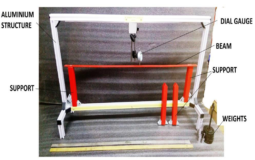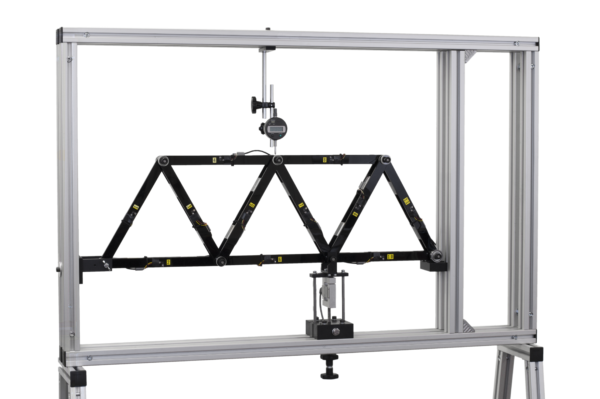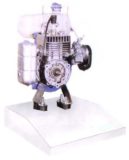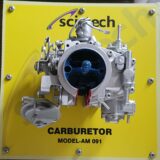Pin Jointed Frameworks Model MT 099
Home » Products » Pin Jointed Frameworks Model MT 099
Pin Jointed Frameworks Model MT 099
Sci-tech Pin Jointed Frameworks Model MT 099 includes two framework supports: a pivoting support, and a pivoting and rolling support. Each member has a strain gauge attached that connects to a digital strain bridge. A load cell applies loads to the structure at various angles. When connected to the optional Digital Force Display, the load cell measures the applied load. To apply loads simultaneously, extra load cells are available. A digital deflection indicator measures the deflection and the digital strain bridge shows the strains in the members. From this, students can calculate the forces in the members. A second tray stores the joint bosses and other loose items. Included is a lead to connect the load cell to a Digital Force Display (to be purchased available separately). The lecturer guide provides details of the equipment including sample experiment results. The student guide describes how to use the equipment and gives experiment procedures.
They also extend the choice of tests beyond that available using only the hardware, for example: higher loads, uniform loads or different test specimens. This extends the
student’s learning experience.
For automatic data acquisition of your experiment results, Sci-tech can supply the optional ‘Sci-Cal’ Automatic Data Acquisition Unit.
| Size: | 120cm x 55cm x 110cm (LxWxH) |
| Weight: | 35 kg |
Item Description
Sci-tech Pin Jointed Frameworks Model MT 099 fits onto a Structures Test Frame. Students use stainless-steel members to build different pin-jointed frameworks. The members joined by slotting the ends into bosses.
The equipment includes two framework supports: a pivoting support, and a pivoting and rolling support. Each member has a strain gauge attached that connects to a digital strain bridge. A load cell applies loads to the structure at various angles. When connected to the optional Digital Force Display, the load cell measures the applied load. To apply loads simultaneously, extra load cells are available. A digital deflection indicator measures the deflection and the digital strain bridge shows the strains in the members. From this, students can calculate the forces in the members. A second tray stores the joint bosses and other loose items. Included is a lead to connect the load cell to a Digital Force Display (to be purchased available separately). The lecturer guide provides details of the equipment including sample experiment results. The student guide describes how to use the equipment and gives experiment procedures.
They also extend the choice of tests beyond that available using only the hardware, for example: higher loads, uniform loads or different test specimens. This extends the
student’s learning experience.
For automatic data acquisition of your experiment results, Sci-tech can supply the optional ‘Sci-Cal’ Automatic Data Acquisition Unit.
See also different:

Sci-tech Bending Moment Apparatus Model MT 069, experimental beam is in two parts, joined together by a pair of low friction ball bearings. An under slung spring balance provides a resisting moment, and also allows the section bending moment t [...]



